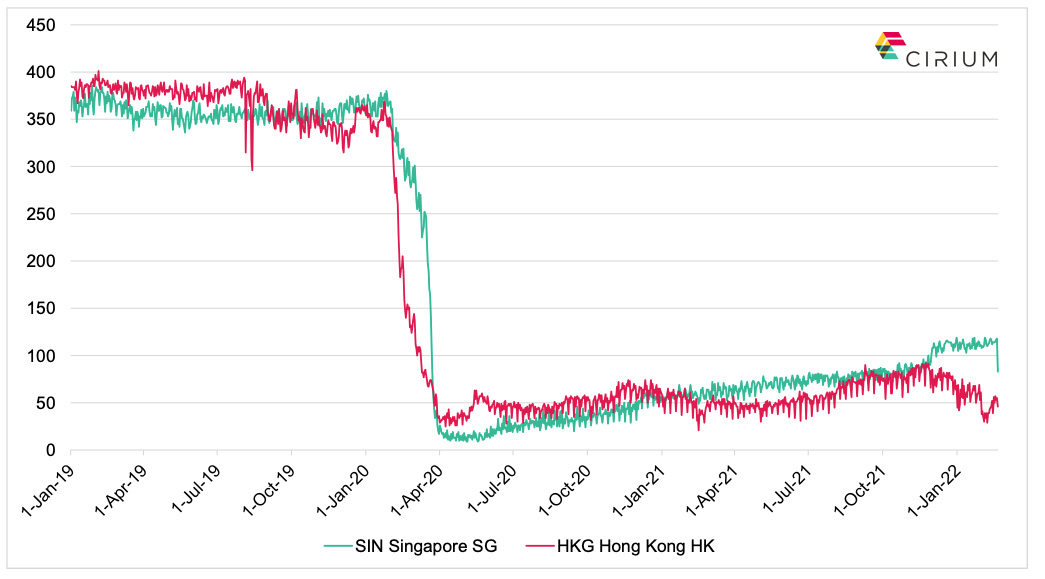READ ALL OF THE LATEST UPDATES FROM ASCEND BY CIRIUM EXPERTS WHO DELIVER POWERFUL ANALYSIS, COMMENTARIES AND PROJECTIONS TO AIRLINES, AIRCRAFT BUILD AND MAINTENANCE COMPANIES, FINANCIAL INSTITUTIONS, INSURERS AND NON-BANKING FINANCIERS.
MEET THE ASCEND BY CIRIUM TEAM

By Eric Tamang, Valuations analyst at Ascend by Cirium
Since the beginning of the COVID-19 pandemic, international travel has taken a severe impact as governments worldwide initiate national lockdowns and close their borders in a bid to curb the spread of COVID-19. In particular, places such as Hong Kong and Singapore are hit even harder as they lack a domestic market to rely on.
Prior to the pandemic in early 2019, both Hong Kong and Singapore had a daily number of tracked departures of nearly 400 aircraft. Going into 2020, Ascend by Cirium’s tracked utilization showed a significant decrease in the daily number of tracked departures to around 50 aircraft each for both Hong Kong and Singapore. However, Singapore is now showing signs of steady improvement, whereas Hong Kong shows no sign of rebounding.
Daily tracked departing flights (Hong Kong and SIngapore)

Hong Kong’s defacto flag carrier Cathay Pacific and Singapore’s flag carrier Singapore Airlines have each reported significant losses for their 2021/22 financial year. Singapore Airlines (SIA) Group reported a loss of around US$623million whereas Cathay Pacific Group reported a loss of around US$972million for the first half of 2021. Ascend by Cirium’s tracked utilization also shows a sharp decrease in daily flights tracked of both airlines since 2020.
Both Hong Kong and Singapore adopted a “zero Covid” policy which makes it even harder to restore international air travel as covid cases will inevitably arise from time to time. However, as global vaccination rates improve, travel restrictions are gradually easing, and countries are switching to a “living with Covid” strategy. In the second quarter of 2021, Singapore adopted a new normal and living with covid strategy, whereas Hong Kong continues with a “zero covid” policy. Since then, Ascend by Cirium’s tracked utilization shows the daily flights tracked of Cathay Pacific and Singapore Airlines diverge fundamentally.
Daily tracked departing flights (Cathay Pacific and Singapore Airlines)

Ascend by Cirium’s Fleets Analyzer lists a total of 105 aircraft in service and 83 in storage with Cathay Pacific. Given the tough measures adopted by Hong Kong, there seems a real risk that Cathay Pacific could fail, which in turn could create a strong downward pressure on aircraft values as aircraft flood the market.
Hong Kong is currently battling its fifth wave of infections with daily cases on the rise. Stricter border controls make international travel very difficult as Hong Kong implemented destination-specific flight suspensions for nine countries, which include Australia, Canada, France, India, Nepal, Pakistan, the Philippines, the UK, and the US. All passenger flights from these places will be prohibited from landing in Hong Kong. In addition, Chinese President Mr. Xi Jinping has said controlling the Omicron variant in the city should take “priority over everything else”.
Many travelers cannot afford the additional costs and time for PCR tests and quarantine after returning to Hong Kong. With no end in sight to Hong Kong’s “zero Covid“ strategy, there needs to a be sustainable balance between healthcare and economic activities to ensure the timely recovery of Hong Kong’s aviation industry.
SEE MORE ASCEND BY CIRIUM POSTS.
























































